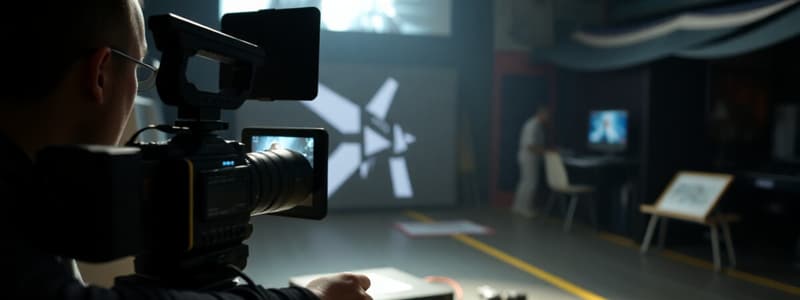Podcast
Questions and Answers
What role does the director play in the filmmaking process?
What role does the director play in the filmmaking process?
- The director only handles editing and post-production.
- The director chooses the film's marketing strategy.
- The director is responsible for the financial aspects of the film.
- The director conveys meaning and personal vision. (correct)
Which of the following techniques is NOT part of a director's creative choices in film?
Which of the following techniques is NOT part of a director's creative choices in film?
- Sound
- Editing
- Financial planning (correct)
- Cinematography
What is the primary purpose of quick cuts in film?
What is the primary purpose of quick cuts in film?
- To provide a sense of serenity.
- To reveal character depth.
- To convey a sense of danger. (correct)
- To extend the narrative time.
Which film industry is known for its high financial investment and global reach?
Which film industry is known for its high financial investment and global reach?
Which invention allowed for the first successful commercial photography?
Which invention allowed for the first successful commercial photography?
Who is credited with the invention of the calotype process?
Who is credited with the invention of the calotype process?
What major advancement did Kodak contribute to photography?
What major advancement did Kodak contribute to photography?
Which step comes directly after 'Post-production' in the film production process?
Which step comes directly after 'Post-production' in the film production process?
Flashcards
Quick cuts
Quick cuts
Quick cuts are a film editing technique where shots are changed rapidly, creating a sense of urgency, danger, or excitement.
Film editing
Film editing
The process of manipulating the order and duration of shots in a film to create a specific narrative or emotional effect.
Mis-en-scène
Mis-en-scène
The visual elements of a film, such as setting, lighting, costumes, and makeup, which contribute to the overall atmosphere and mood.
Cinematography
Cinematography
Signup and view all the flashcards
Film sound
Film sound
Signup and view all the flashcards
Business of film
Business of film
Signup and view all the flashcards
Bollywood
Bollywood
Signup and view all the flashcards
Hollywood
Hollywood
Signup and view all the flashcards
Study Notes
Film Studies
- Film is a powerful emotional experience that brings stories to life.
- Quick cuts create a sense of danger and action.
- Editing manipulates time and space through camera techniques.
- Directors are key figures in conveying meaning and a personal vision.
- Mise-en-scene elements (setting, lighting, costumes, makeup) are used by directors.
- Cinematography (camera techniques) are also a creative element.
- Sound and editing are important aspects of film.
- Film production is a complex process with 12 stages.
- The first stage involves the initial idea from producers, directors, or writers.
- Companies may buy the idea.
- Film companies fund through financing.
- Pre-production, production, and post-production are crucial stages.
- Sales agents are used to market films.
- Films often exhibit at film festivals.
- Distributors market films and sell them in theaters.
- Major film industries exist in locations like Hollywood, Bollywood, and Nollywood.
Photography
- Photography isn't just about copying but interpreting reality.
- The camera obscura is a device that projects images.
- The first successful photograph was a daguerreotype.
- Daguerreotypes used polished metal plates for exposure.
- Calotype process recorded photographs on paper.
- Kodak revolutionized photography by providing a simple box camera.
- Digital Single Lens Reflex (DSLR) cameras use a mirror to view the subject.
- Lenses alter how subjects appear in photos.
- Light meters measure ambient light for accurate exposure.
- Photography ancestors include Stephen Shore, and others.
Studying That Suits You
Use AI to generate personalized quizzes and flashcards to suit your learning preferences.




